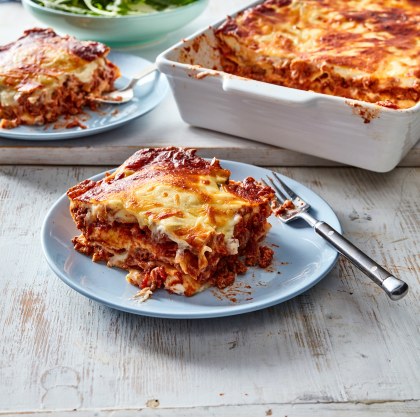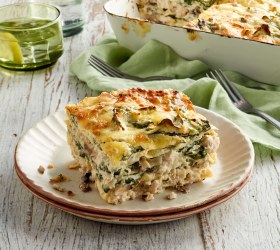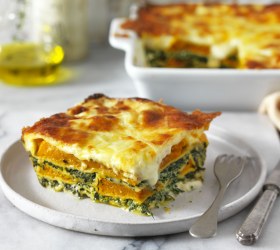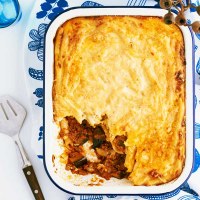What is béchamel? What is the difference between white sauce, cheese sauce and Mornay sauce?
Béchamel, white sauce, cheese sauce and Mornay sauce are all roux-based sauces. That means they are thickened with a roux, which is made with equal parts fat and flour cooked into a paste.
Traditionally, the fat used is butter, but almost any fat including vegetable oil, bacon fat and even margarine can be substituted. Wheat flour is the most commonly used starch, but other options include bread or cake flour, cornflour or arrowroot, gluten-free flours and even self-raising flour.
- Béchamel (also known as white sauce) is the basic sauce known as the “mother sauce”. It’s used across many cuisines, you may know it best as a component of lasagne. Béchamel begins with a blonde roux, which is butter and flour cooked together until straw in colour. Milk is added to turn it into a rich sauce. Traditionally the milk is first heated with aromatics such as onion, pepper, bay leaf and mace to infuse it with flavours.
- White sauce is more simple. It generally uses mustard (Dijon or English) for added flavour, and cold plain milk instead of infused milk. This version is quicker but still delicious.
- Cheese sauce is also known as a Mornay sauce. This sauce is the basic white sauce enriched with cheese. Gruyere, Emmental cheese, or cheddar. A Mornay sauce made with cheddar is commonly used to make macaroni and cheese such as this Cauliflower Mac 'n' Cheese.
How to make béchamel sauce
Ingredients:
- 1 L (4 cups) milk
- 1 brown onion, halved, coarsely chopped
- 8 fresh parsley stalks
- 8 whole black peppercorns
- 4 whole cloves
- 2 bay leaves
- 3 tbsps Butter
- ⅓ cup (50 g) plain flour
- 1 cup Parmesan cheese (grated)
- Pinch ground nutmeg, salt & pepper, to taste
Method:
- Combine the milk, onion, parsley stalks, peppercorns, cloves and bay leaves in a medium saucepan and bring to a simmer over medium heat. Remove from heat and set aside for 15 minutes to infuse. Strain the milk mixture through a fine sieve into a large jug. Discard solids.
- Melt the butter in a large saucepan over medium-high heat until foaming. Add the flour and stir with a wooden spoon until flour and butter form a paste, this is the roux. Stir continuously for 1-2 minutes. The colour should change to a straw colour with no visible unmixed flour. It will smell nutty and fragrant.
- Add half of the milk mixture, whisking continuously. Whisk until thick, don’t worry if it appears lumpy. Add the rest of the milk, whisking continuously. The sauce should appear smoother.
- Bring the sauce to a boil. Reduce the heat to medium and allow the sauce to boil for at least 5 minutes, stirring with a spoon. This step is important or your sauce will taste floury. Your sauce should be glossy and smooth and coat the back of the spoon.
- Now if your sauce is lump free and thick to your liking, season with salt and pepper and stir in parmesan.
- If your sauce is lumpy, pour through a fine mesh sieve directly into a clean saucepan. Heat on low heat and season to taste. Stir through parmesan.
Tips and Tricks
- Using a whisk when you add milk to the roux will help to break up any lumps. Once the all the milk has been added and the sauce is simmering, you can switch to a wooden spoon.
- Room temperature milk is not essential, but lumps are less likely to form if you use it. Measure out your milk and heat it for 30 secs in the microwave. Stir and repeat until it feels lukewarm.
- Haven’t got enough milk? Dilute cream with water, or use a milk substitute such as almond or soy milk. These will alter the flavour of the sauce however. You can also use stock, which will turn your sauce into a velouté.
- If your bechamel is too thick, add milk. If it's too thin, you can reduce it by letting it simmer for longer or add more roux. Read more about how to thicken or thin out béchamel here.
- If you're low on time, make a cheat's bechamel or bechamel in the microwave.
- Bechamel keeps in the fridge for up to one week, you can also freeze it with these steps.
Now you have the perfect silky and flavourful béchamel! Why not use it in one of the recipes below?
GET THE RECIPE: Classic Beef Lasagne by Perfect Italiano
This lasagne is layered with classic béchamel infused with delicious flavours, making for the tastiest finished dish.
GET THE RECIPE: Baked Mac and Cheese by Perfect Italiano
You can't go wrong with this cosy comfort food.





















